概念
在计算机科学中,AVL树(以发明者 Adelson-Velsky 和 Landis 命名)是一种自平衡的二叉搜索树(BST)。
特点:
- 本身首先是一棵二叉搜索树。
- 带有平衡条件:每个结点的左右子树的高度之差的绝对值(平衡因子)最多为1。
也就是说,AVL树,本质上是带了平衡功能的二叉搜索树。
框架
我们把它设计成三叉链表,即每个结点不仅可以找到它的左右孩子结点,也可以找到它的父亲结点。为了方便平衡,每个结点给一个平衡因子(balance factor)
template<class K, class V>
struct AVLTreeNode
{
pair<K, V> _kv;
AVLTreeNode<K, V>* _left;
AVLTreeNode<K, V>* _right;
AVLTreeNode<K, V>* _parent;
// 右子树-左子树高度差
int _bf; // balance factor
AVLTreeNode(const pair<K, V>& kv)
: _kv(kv)
, _left(nullptr)
, _right(nullptr)
, _parent(nullptr)
, _bf(0)
{}
};
template<class K, class V>
class AVLTree
{
typedef AVLTreeNode<K, V> Node;
public:
private:
Node* _root;
};
插入
按搜索树规则插入
bool Insert(const pair<K, V>& kv)
{
if (_root == nullptr)
{
_root = new Node(kv);
_root->_bf = 0;
return true;
}
Node* parent = nullptr;
Node* cur = _root;
while (cur)
{
if (cur->_kv.first < kv.first)
{
parent = cur;
cur = cur->_right;
}
else if (cur->_kv.first > kv.first)
{
parent = cur;
cur = cur->_left;
}
else
{
return false;
}
}
cur = new Node(kv);
if (parent->_kv.first < kv.first)
parent->_right = cur;
else
parent->_left = cur;
cur->_parent = parent;
//...
}
更新平衡因子
首先要明确一点,一个结点的平衡因子由子树的高度差决定,也就是说,子树的高度变化只会影响祖先的平衡因子,对堂兄弟等结点没有影响。
-
当你找到要插入的位置时,该位置的父结点平衡因子可能有三种情况:-1、0、1,这说明该结点一定只有 0 或 1 个孩子(因为至少留有一个要插入的位置),且高度为 1 或 2(叶子结点高度按 1 算)。
-
若插入到左边,则父结点平衡因子 -1,插入到右边,父结点平衡因子 +1
-
插入后,如果父结点的平衡因子变为 0,说明整棵树的高度没有改变,其上的各个祖先结点的平衡因子也就不需要更新
-
插入后,如果父结点的平衡因子变为 -1 或 1,说明该子树的高度发生了改变,需要继续向上调整各个祖先结点的平衡因子。
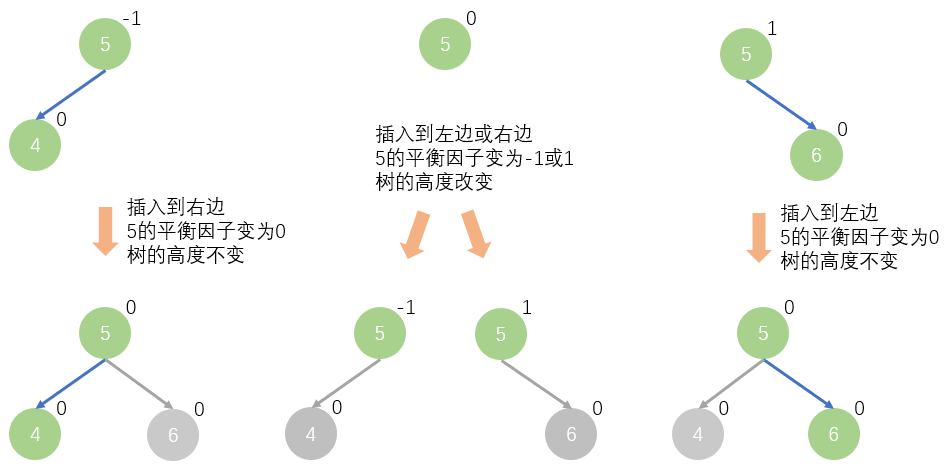
- 更新后的平衡因子为-1、0、1都属于正常,不用调整,如果为-2、2,说明子树不平衡,需要调整,如果绝对值大于2,说明程序出错了,不满足AVL树的条件。
//...
// 更新平衡因子
while (parent) // 最远更新到根
{
if (cur == parent->_right)
{
++parent->_bf;
}
else
{
--parent->_bf;
}
// 是否继续更新
if (parent->_bf == 0)// 为0,更新结束
{
break;
}
else if (parent->_bf == 1 || parent->_bf == -1)
{
cur = cur->_parent;
parent = parent->_parent;
}
else if (parent->_bf == 2 || parent->_bf == -2)
{
// 子树不平衡,需要旋转处理
}
else
{
// 插入前就不满足AVL树的条件,程序出错
assert(false);
}
}
return true;
}
旋转
对于不平衡的树,我们通过旋转来调整
调整原则:
- 保持搜索树的规则
- 子树变平衡
根据结点插入位置的不同,AVL树的旋转分为四种:
- 新结点插入在其较高右子树的右侧——右右:左旋
下图是一个抽象图,绿三角表示任意的高度相等的AVL树
具体旋转步骤为,将 subRL 变为 parent 的右子树,然后 parent 成为 subR 的左子树
并且旋转完成后,整棵树的高度又回到插入元素之前,也就不需要继续向上调整平衡因子了。
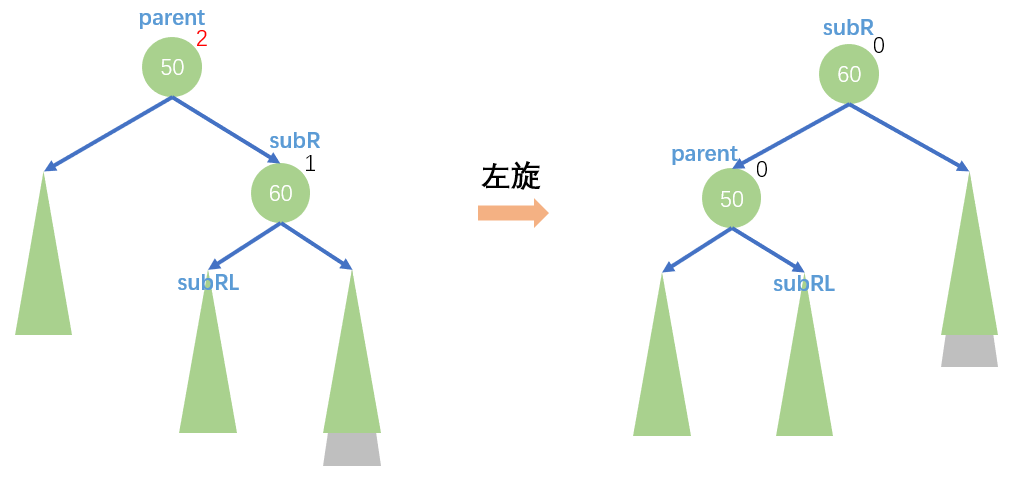
写代码时要注意这是三叉链表,需要考虑结点的 _parent 指针。
private:
void RotateL(Node* parent)
{
Node* subR = parent->_right;
Node* subRL = subR->_left;
parent->_right = subRL;
if (subRL) subRL->_parent = parent; // subRL有可能是空树,需要if判断
Node* ppNode = parent->_parent; // 提前记录祖先,后面用来连接新的parent
subR->_left = parent;
parent->_parent = subR;
if (parent == _root) // 如果parent就是根结点,那么新的根是subR
{
_root = subR;
_root->_parent = nullptr;
}
else // 否则需要祖先来连接新的parent(即subR),注意判断左右
{
if (parent == ppNode->_left)
{
ppNode->_left = subR;
}
else
{
ppNode->_right = subR;
}
subR->_parent = ppNode;
}
// 更新平衡因子
parent->_bf = 0;
subR->_bf = 0;
}
- 新结点插入在其较高左子树的左侧——左左:右旋
思路和左旋差不多:
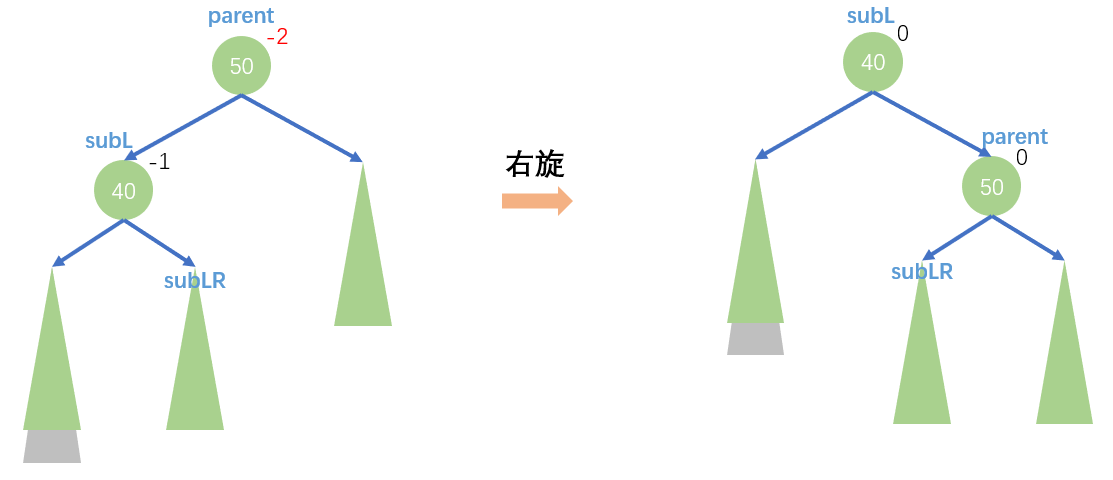
void RotateR(Node* parent)
{
Node* subL = parent->_left;
Node* subLR = subL->_right;
parent->_left = subLR;
if (subLR) subLR->_parent = parent;
Node* ppNode = parent->_parent;
subL->_right = parent;
parent->_parent = subL;
if (parent == _root)
{
_root = subL;
_root->_parent = nullptr;
}
else
{
if (parent == ppNode->_left)
{
ppNode->_left = subL;
}
else
{
ppNode->_right = subL;
}
subL->_parent = ppNode;
}
parent->_bf = 0;
subL->_bf = 0;
}
- 新结点插入在较高左子树的右侧——左右:先左旋再右旋
如下图,深绿色三角表示任意高度相等的AVL树,浅绿色三角比深绿色三角高度低1层
这种情况下又分三个小情况
- 新结点插入在
subLR的左子树,subLR的平衡因子变为 -1 - 新结点插入在
subLR的右子树,subLR的平衡因子变为 1 subLR就是新结点,(即深绿色三角高度为 0,浅绿色三角不存在),subLR的平衡因子为 0
不管是哪种情况,旋转方式都一样,先对 subL 子树左旋,然后对 parent 右旋。
旋转后的高度和插入前相等,也不用继续向上更新祖先的平衡因子。
旋转后需要更新平衡因子,对应旋转前 subLR 的平衡因子,旋转后的平衡因子分别为:
- 旋转前
sunLR:-1;旋转后parent:1,subL:0,subLR:0 - 旋转前
subLR:1;旋转后parent:0,subL:-1,subLR:0 - 旋转前
subLR:0;旋转后parent:0,subL:0,subLR:0
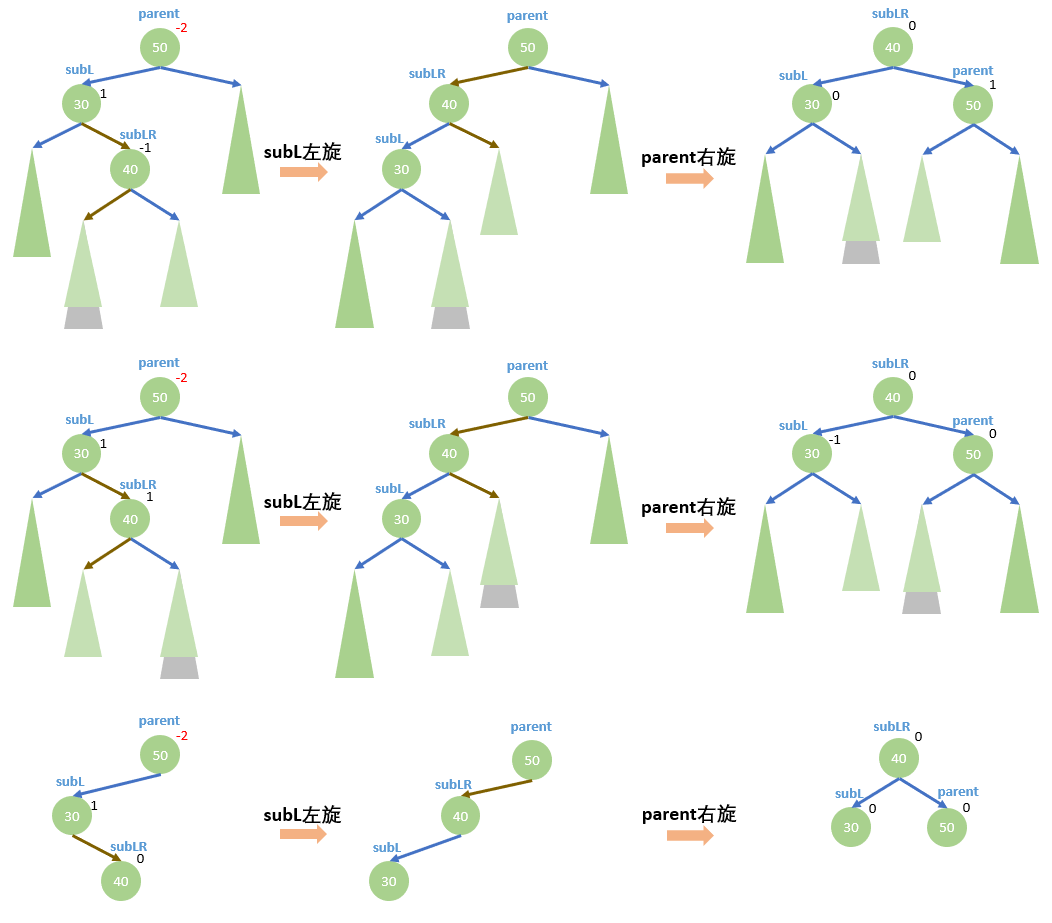
代码其实很简单,因为可以复用已经写好的左旋和右旋。
void RotateLR(Node* parent)
{
Node* subL = parent->_left; // 提前记录subL和subLR以及subLR的bf,方便后面更新平衡因子
Node* subLR = subL->_right;
int bf = subLR->_bf;
// 复用左旋和右旋
RotateL(parent->_left);
RotateR(parent);
// 更新平衡因子
if (bf == 0)
{
parent->_bf = 0;
subL->_bf = 0;
subLR->_bf = 0;
}
else if (bf == 1)
{
parent->_bf = 0;
subL->_bf = -1;
subLR->_bf = 0;
}
else if (bf == -1)
{
parent->_bf = 1;
subL->_bf = 0;
subLR->_bf = 0;
}
else
{
assert(false);
}
}
- 新结点插入在较高右子树的左侧——右左:先右旋再左旋
旋转后需要更新平衡因子,对应旋转前 subRL 的平衡因子,旋转后的平衡因子分别为:
- 旋转前
sunRL:-1;旋转后parent:0,subR:1,sunRL:0 - 旋转前
sunRL:1;旋转后parent:-1,subR:0,sunRL:0 - 旋转前
sunRL:0;旋转后parent:0,subR:0,sunRL:0
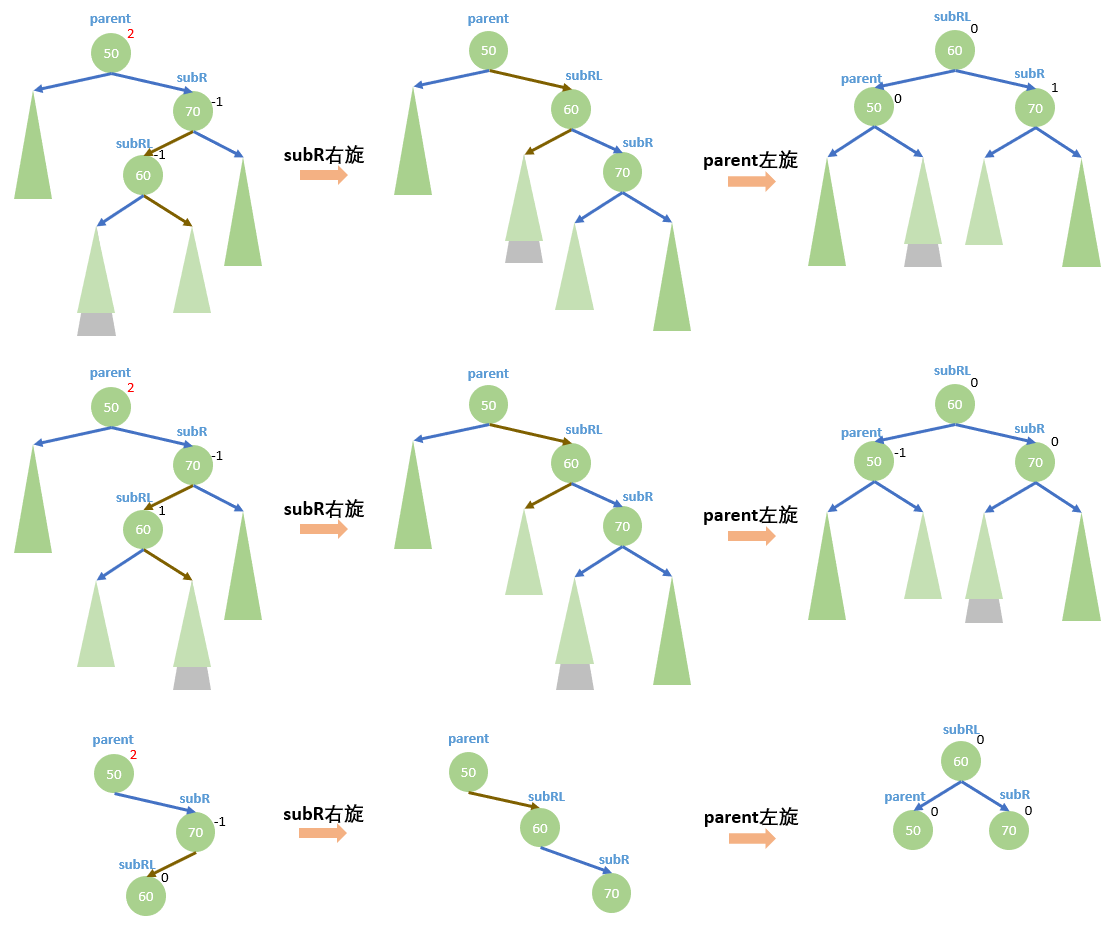
void RotateRL(Node* parent)
{
Node* subR = parent->_right; // 提前记录subR和subRL以及subRL的bf,方便后面更新平衡因子
Node* subRL = subR->_left;
int bf = subRL->_bf;
// 复用右旋和左旋
RotateR(parent->_right);
RotateL(parent);
// 更新平衡因子
if (bf == 0)
{
parent->_bf = 0;
subR->_bf = 0;
subRL->_bf = 0;
}
else if (bf == 1)
{
parent->_bf = -1;
subR->_bf = 0;
subRL->_bf = 0;
}
else if (bf == -1)
{
parent->_bf = 0;
subR->_bf = 1;
subRL->_bf = 0;
}
else
{
assert(false);
}
}
到此为止,四种旋转调整的实现已经完成了,最后判断一下什么情况下用什么旋转:
- parent的平衡因子为 2,cur的平衡因子为 1,右右,需要左旋
- parent的平衡因子为 -2,cur的平衡因子为 -1,左左,需要右旋
- parent的平衡因子为 -2,cur的平衡因子为 1,左右,需要左右双旋
- parent的平衡因子为 2,cur的平衡因子为 -1,右左,需要右左双旋
旋完直接 break 不用继续往上更新平衡因子。
//...
else if (parent->_bf == 2 || parent->_bf == -2)
{
// 子树不平衡,需要旋转处理
if (parent->_bf == 2 && cur->_bf == 1) // 右右——左旋
{
RotateL(parent);
}
else if (parent->_bf == -2 && cur->_bf == -1) // 左左——右旋
{
RotateR(parent);
}
else if (parent->_bf == -2 && cur->_bf == 1) // 左右——左右旋
{
RotateLR(parent);
}
else if (parent->_bf == 2 && cur->_bf == -1) // 右左——右左旋
{
RotateRL(parent);
}
break;
}
//...
这里我们可以验证写出来的是不是AVL树,
-
通过层序遍历直观感受AVL树的长相。
-
通过逻辑检查是否符合AVL树的规则。
public:
void LevelOrder()
{
queue<Node*> que;
if (_root != NULL) que.push(_root);
while (!que.empty())
{
int size = que.size();
for (int i = 0; i < size; i++)
{
Node* node = que.front();
que.pop();
cout << node->_kv.first << ' ';
if (node->_left) que.push(node->_left);
if (node->_right) que.push(node->_right);
}
cout << endl;
}
}
bool IsAVLTree()
{
return _IsAVLTree(_root);
}
private:
bool _IsAVLTree(Node* root)
{
if (root == nullptr) return true; // 空树也是AVL树
// 递归获得左右子树的高度
int leftHeight = _Height(root->_left);
int rightHeight = _Height(root->_right);
int diff = rightHeight - leftHeight;
if (abs(diff) > 1) // 直接判断高度差是否符合要求
{
cout << root->_kv.first << "结点左右子树不平衡";
return false;
}
if (diff != root->_bf) // 判断平衡因子是否符合实际
{
cout << root->_kv.first << "结点平衡因子不符合实际";
return false;
}
return _IsAVLTree(root->_left) && _IsAVLTree(root->_right); // 递归检查各个结点
}
int _Height(Node* root)
{
if (root == nullptr) return 0;
int leftDepth = _Height(root->_left);
int rightDepth = _Height(root->_right);
return leftDepth > rightDepth ? leftDepth + 1 : rightDepth + 1;
}
插入随机值,然后检查:
void test2()
{
const size_t N = 100;
vector<int> v;
v.reserve(N);
for (size_t i = 0; i < N; ++i)
{
v.push_back(rand());
}
AVLTree<int, int> t;
for (auto e : v)
{
t.Insert(make_pair(e, 0));
}
t.LevelOrder();
cout << endl;
cout << t.IsAVLTree();
}

顺序插入检查:

结果完美符合预期!
完整代码
#pragma once
#include <iostream>
#include <cassert>
#include <vector>
#include <queue>
using namespace std;
template<class K, class V>
struct AVLTreeNode
{
pair<K, V> _kv;
AVLTreeNode<K, V>* _left;
AVLTreeNode<K, V>* _right;
AVLTreeNode<K, V>* _parent;
// 右子树-左子树高度差
int _bf; // balance factor
AVLTreeNode(const pair<K, V>& kv)
: _kv(kv)
, _left(nullptr)
, _right(nullptr)
, _parent(nullptr)
, _bf(0)
{}
};
template<class K, class V>
class AVLTree
{
typedef AVLTreeNode<K, V> Node;
public:
bool Insert(const pair<K, V>& kv)
{
if (_root == nullptr)
{
_root = new Node(kv);
_root->_bf = 0;
return true;
}
Node* parent = nullptr;
Node* cur = _root;
while (cur)
{
if (cur->_kv.first < kv.first)
{
parent = cur;
cur = cur->_right;
}
else if (cur->_kv.first > kv.first)
{
parent = cur;
cur = cur->_left;
}
else
{
return false;
}
}
cur = new Node(kv);
if (parent->_kv.first < kv.first)
parent->_right = cur;
else
parent->_left = cur;
cur->_parent = parent;
// 更新平衡因子
while (parent) // 最远更新到根
{
if (cur == parent->_right)
{
++parent->_bf;
}
else
{
--parent->_bf;
}
// 是否继续更新
if (parent->_bf == 0)// 为0,更新结束
{
break;
}
else if (parent->_bf == 1 || parent->_bf == -1)
{
cur = cur->_parent;
parent = parent->_parent;
}
else if (parent->_bf == 2 || parent->_bf == -2)
{
// 子树不平衡,需要旋转处理
if (parent->_bf == 2 && cur->_bf == 1) // 右右——左旋
{
RotateL(parent);
}
else if (parent->_bf == -2 && cur->_bf == -1) // 左左——右旋
{
RotateR(parent);
}
else if (parent->_bf == -2 && cur->_bf == 1) // 左右——左右旋
{
RotateLR(parent);
}
else if (parent->_bf == 2 && cur->_bf == -1) // 右左——右左旋
{
RotateRL(parent);
}
break;
}
else
{
// 插入前就不满足AVL树的条件,程序出错
assert(false);
}
}
return true;
}
void LevelOrder()
{
queue<Node*> que;
if (_root != NULL) que.push(_root);
while (!que.empty())
{
int size = que.size();
for (int i = 0; i < size; i++)
{
Node* node = que.front();
que.pop();
cout << node->_kv.first << ' ';
if (node->_left) que.push(node->_left);
if (node->_right) que.push(node->_right);
}
cout << endl;
}
}
bool IsAVLTree()
{
return _IsAVLTree(_root);
}
private:
bool _IsAVLTree(Node* root)
{
if (root == nullptr) return true;
int leftHeight = _Height(root->_left);
int rightHeight = _Height(root->_right);
int diff = rightHeight - leftHeight;
if (abs(diff) > 1)
{
cout << root->_kv.first << "结点左右子树不平衡";
return false;
}
if (diff != root->_bf)
{
cout << root->_kv.first << "结点平衡因子不符合实际";
return false;
}
return _IsAVLTree(root->_left) && _IsAVLTree(root->_right);
}
int _Height(Node* root)
{
if (root == nullptr) return 0;
int leftDepth = _Height(root->_left);
int rightDepth = _Height(root->_right);
return leftDepth > rightDepth ? leftDepth + 1 : rightDepth + 1;
}
private:
void RotateL(Node* parent)
{
Node* subR = parent->_right;
Node* subRL = subR->_left;
parent->_right = subRL;
if (subRL) subRL->_parent = parent; // subRL有可能是空树,需要if判断
Node* ppNode = parent->_parent; // 提前记录祖先,后面用来连接新的parent
subR->_left = parent;
parent->_parent = subR;
if (parent == _root) // 如果parent就是根结点,那么新的根是subR
{
_root = subR;
_root->_parent = nullptr;
}
else // 否则需要祖先来连接新的parent(即subR),注意判断左右
{
if (parent == ppNode->_left)
{
ppNode->_left = subR;
}
else
{
ppNode->_right = subR;
}
subR->_parent = ppNode;
}
// 更新平衡因子
parent->_bf = 0;
subR->_bf = 0;
}
void RotateR(Node* parent)
{
Node* subL = parent->_left;
Node* subLR = subL->_right;
parent->_left = subLR;
if (subLR) subLR->_parent = parent;
Node* ppNode = parent->_parent;
subL->_right = parent;
parent->_parent = subL;
if (parent == _root)
{
_root = subL;
_root->_parent = nullptr;
}
else
{
if (parent == ppNode->_left)
{
ppNode->_left = subL;
}
else
{
ppNode->_right = subL;
}
subL->_parent = ppNode;
}
parent->_bf = 0;
subL->_bf = 0;
}
void RotateLR(Node* parent)
{
Node* subL = parent->_left; // 提前记录subL和subLR以及subLR的bf,方便后面更新平衡因子
Node* subLR = subL->_right;
int bf = subLR->_bf;
// 复用左旋和右旋
RotateL(parent->_left);
RotateR(parent);
// 更新平衡因子
if (bf == 0)
{
parent->_bf = 0;
subL->_bf = 0;
subLR->_bf = 0;
}
else if (bf == 1)
{
parent->_bf = 0;
subL->_bf = -1;
subLR->_bf = 0;
}
else if (bf == -1)
{
parent->_bf = 1;
subL->_bf = 0;
subLR->_bf = 0;
}
else
{
assert(false);
}
}
void RotateRL(Node* parent)
{
Node* subR = parent->_right; // 提前记录subR和subRL以及subRL的bf,方便后面更新平衡因子
Node* subRL = subR->_left;
int bf = subRL->_bf;
// 复用右旋和左旋
RotateR(parent->_right);
RotateL(parent);
// 更新平衡因子
if (bf == 0)
{
parent->_bf = 0;
subR->_bf = 0;
subRL->_bf = 0;
}
else if (bf == 1)
{
parent->_bf = -1;
subR->_bf = 0;
subRL->_bf = 0;
}
else if (bf == -1)
{
parent->_bf = 0;
subR->_bf = 1;
subRL->_bf = 0;
}
else
{
assert(false);
}
}
private:
Node* _root = nullptr;
};